NMR-Based Shale Core Imbibition Performance Study
Abstract
:1. Introduction
2. Materials and Methods
2.1. Principle of NMR Imbibition Experiment
2.2. Equipment and Samples
2.3. Methodology and Workflow
- (1)
- All the shale core samples were put into a constant temperature oven at 80 °C for 48 h;
- (2)
- The porosity and permeability of the samples were measured;
- (3)
- The dry shale sample was placed in an NMR analyzer, and the initial T2 spectra distribution was tested, which is taken as the reference signals;
- (4)
- The cores were placed into a corresponding beaker containing test solution vertically, ensuring that the total core was immersed into the solutions, and the starting time was recorded for each sample, record balance reading in real time;
- (5)
- The core was removed at a designated time and the surface fluids were instantly removed using test paper. The sample was placed into the NMR analyzer to measure post-imbibition T2 spectrum;
- (6)
- The imbibition experiment was stopped at a constant sample weight. The core sample was taken out, and the T2 spectrum was tested at state of saturation.
3. Results
3.1. Shale Core Imbibition
3.2. Imbibition Controls
3.2.1. Fractures
3.2.2. Salinity
3.2.3. Surfactant Concentration
3.3. Imbibition Flowback
4. Conclusions
- (1)
- Quickly increased right-peaks in T2 spectra, and first quickly increased and then slow-moving left-peaks that shifted right in the process of shale imbibition indicated rapid water intrusion into fractures at first and then small pores close to fracture walls and deep large pores due to the effect of capillary force.
- (2)
- Imbibition rate and capacity increased with increasing fracture density, decreasing salinity, and decreasing surfactant concentration.
- (3)
- Shale core permeability increased by 8.70–17.88 times with the average of 13.83 times after imbibition flowback in the area of interest. Cracks occurring on the end face and surface of the core indicated that after fluids were imbibed into the matrix pores, microcracks generated by hydration extended and expanded to form a crack network and new filtration channels, which further improved reservoir properties.
Author Contributions
Funding
Institutional Review Board Statement
Informed Consent Statement
Data Availability Statement
Conflicts of Interest
References
- Zou, C.; Zhao, Q.; Cong, L.; Wang, H.; Shi, Z.; Wu, J.; Pan, S. Development progress, potential and prospect of shale gas in China. Natural. Gas Ind. 2021, 41, 1–14. [Google Scholar]
- Zhang, T.; Li, X.; Yang, L.; Li, J.; Wang, Y.; Feng, D.; Yang, J.; Li, F. Effects of shut-in timing on flowback rate and productivity of shale gas wells. Nat. Gas Ind. 2018, 37, 48–60. [Google Scholar]
- Singh, H. A critical review of water uptake by shales. J. Nat. Gas Sci. Eng. 2016, 34, 751–766. [Google Scholar] [CrossRef]
- Cheng, Y. Impact of water dynamics in fractures on the performance of hydraulically fractured wells in gas shale reservoirs. J. Can. Pet. Technol. 2012, 51, 143–151. [Google Scholar] [CrossRef]
- Liu, N.; Liu, M.; Zhang, S. Flowback patterns of fractured shale gas wells. Nat. Gas Ind. 2015, 35, 50–54. [Google Scholar] [CrossRef]
- Gao, S.; Hu, Z.; Guo, W.; Zuo, L.; Shen, R. Water absorption characteristics of gas shale and the fracturing fluid flowback capacity. Nat. Gas Ind. 2013, 33, 71–76. [Google Scholar]
- Wu, K.; Xiong, W.; Hu, Z.; Gao, S. Experimental Study on Influence of Different Degrees of Water Saturation on Seepage Capacity of Shale. Res. Explor. Lab. 2018, 37, 32–35. [Google Scholar]
- Guo, J.; Tao, L.; Chen, C.; Zhao, Y.; He, S.; Liu, Y. Water Imbibition Law of Longmaxi Formation Shale in the South of Sichuan Basin. Chin. J. Comput. Phys. 2021, 38, 565–572. [Google Scholar]
- Xu, F. Spontaneous imbibition characteristics of fracturing fluid in shale gas reservoir considering chemical osmotic pressure. Lithol. Reserv. 2021, 33, 145–152. [Google Scholar]
- Xiong, J.; Chen, S.; Liang, L.; Xiao, Y.; Chen, L.; Yang, L. Imbibition characteristics and influencing factors of Longmaxi Formation shale. J. Guilin Univ. Technol. 2020, 40, 688–694. [Google Scholar]
- Zhu, Y.; Li, Z. Imbibition Behavior and Fluid Dynamic Distribution of Longmaxi Formation Shale in Pengshui Area. Chin. J. Comput. Phys. 2021, 38, 555–564. [Google Scholar]
- Yang, F.; Zuo, L.; Hu, Z.; Wu, G.; Wu, J.; Luo, L. Researching the Water Imbibition Characteristic of Shale by Experiment. Sci. Technol. Eng. 2016, 16, 63–66. [Google Scholar]
- Ye, H.; Ning, Z.; Wang, Q.; Cheng, Z.; Huang, L.; Mu, D. Spontaneous imbibition experiment and wettability of shale reservoir. Fault-Block Oil Gas Field 2019, 26, 84–87. [Google Scholar]
- Xiao, W.; Zhang, J.; Du, Y.; Zhao, J.; Zhao, Z. An Experimental Study on NMR Response Characteristics of Imbibition Subjected to Pressure in Shale. J. Southwest Pet. Univ. 2019, 41, 13–18. [Google Scholar]
- Duan, X.; Hu, Z.; Gu, Z.; Chang, J.; Shen, R.; Sun, W.; Mu, Y.; Zhou, G. Study on the production laws of shale gas in different occurrence states in the use of NMR online detection technology. Nat. Gas Ind. 2021, 41, 76–83. [Google Scholar]
- Deng, W.; Liang, T.; Yuan, S.; Zhou, F. Abnormal Phenomena and Mathematical Model of Fluid Imbibition in a Capillary Tube. Energies 2022, 15, 4994. [Google Scholar] [CrossRef]
- Zhu, W.; Zou, G.; Liu, Y.; Liu, W.; Pan, B. The Influence of Movable Water on the Gas-Phase Threshold Pressure Gradient in Tight Gas Reservoirs. Energies 2022, 15, 5309. [Google Scholar] [CrossRef]
- Lin, H.; Zhang, S.; Wang, F.; Pan, Z.; Mou, J.; Zhou, T.; Ren, Z. Experimental investigation on imbibition-front progression in shale based on nuclear magnetic resonance. Energy Fuels 2016, 30, 9097–9105. [Google Scholar]
- Xiao, L. MRI Logging, Rock MR, and Their Application; Science Press: Beijing, China, 1998. [Google Scholar]
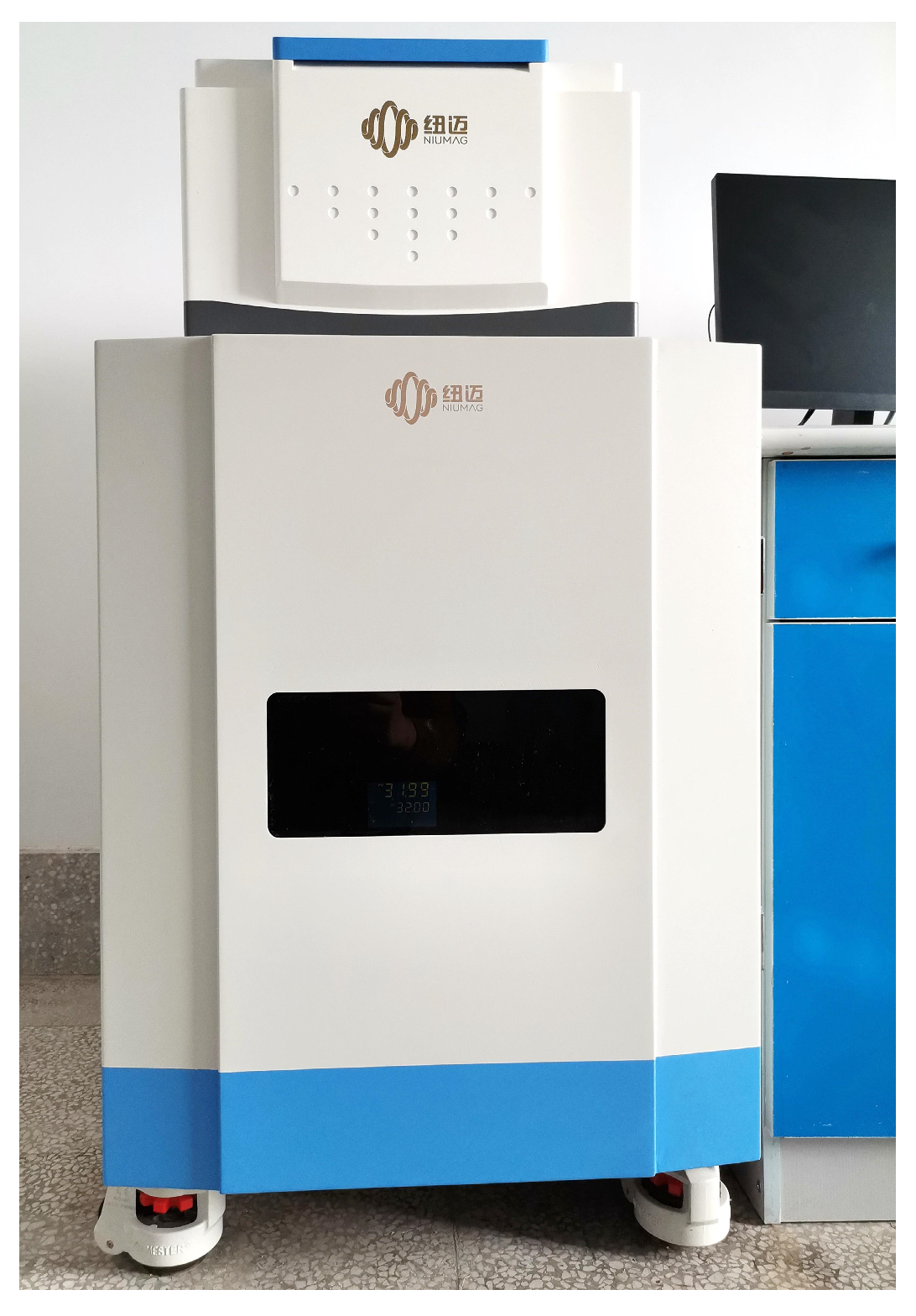


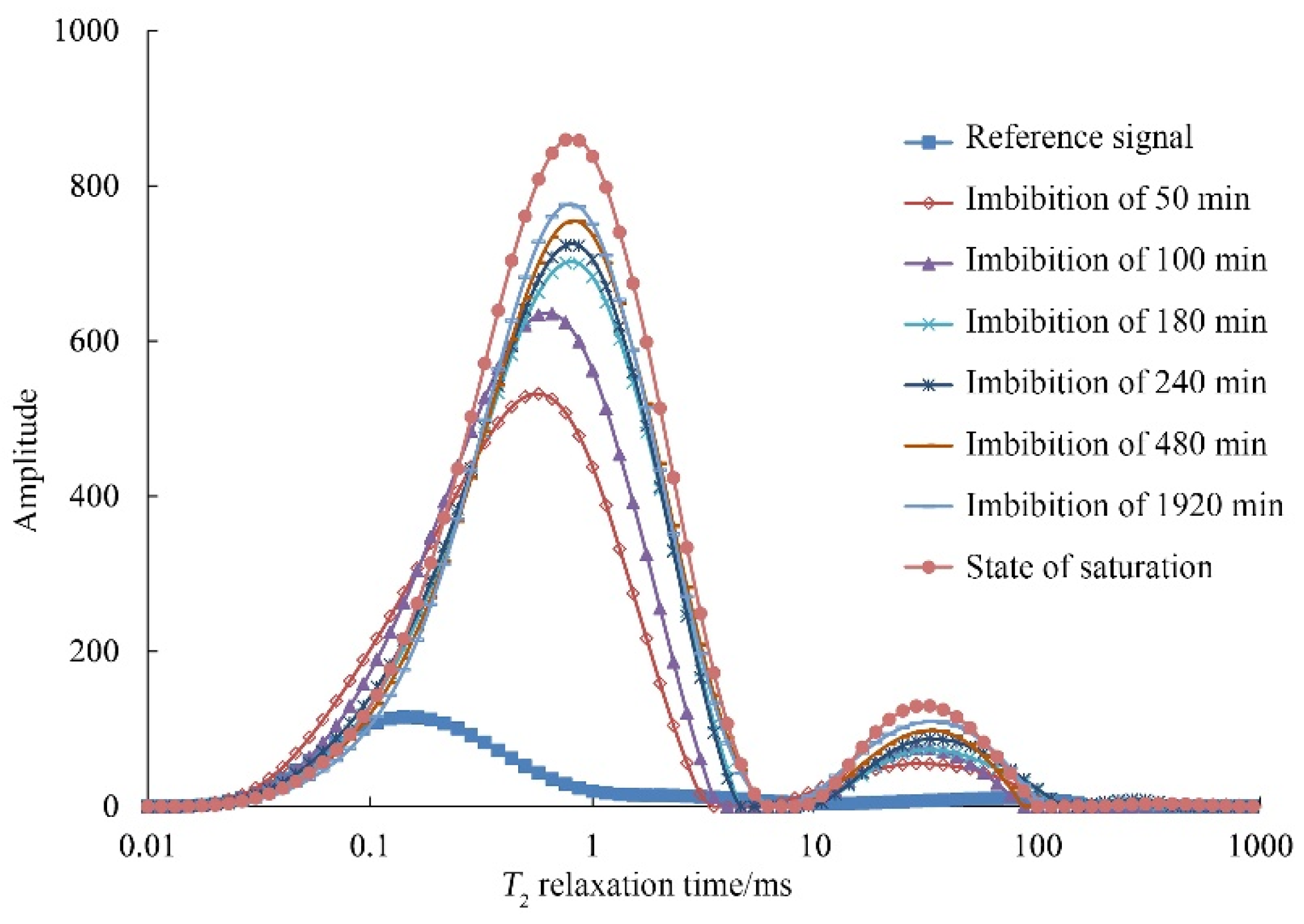
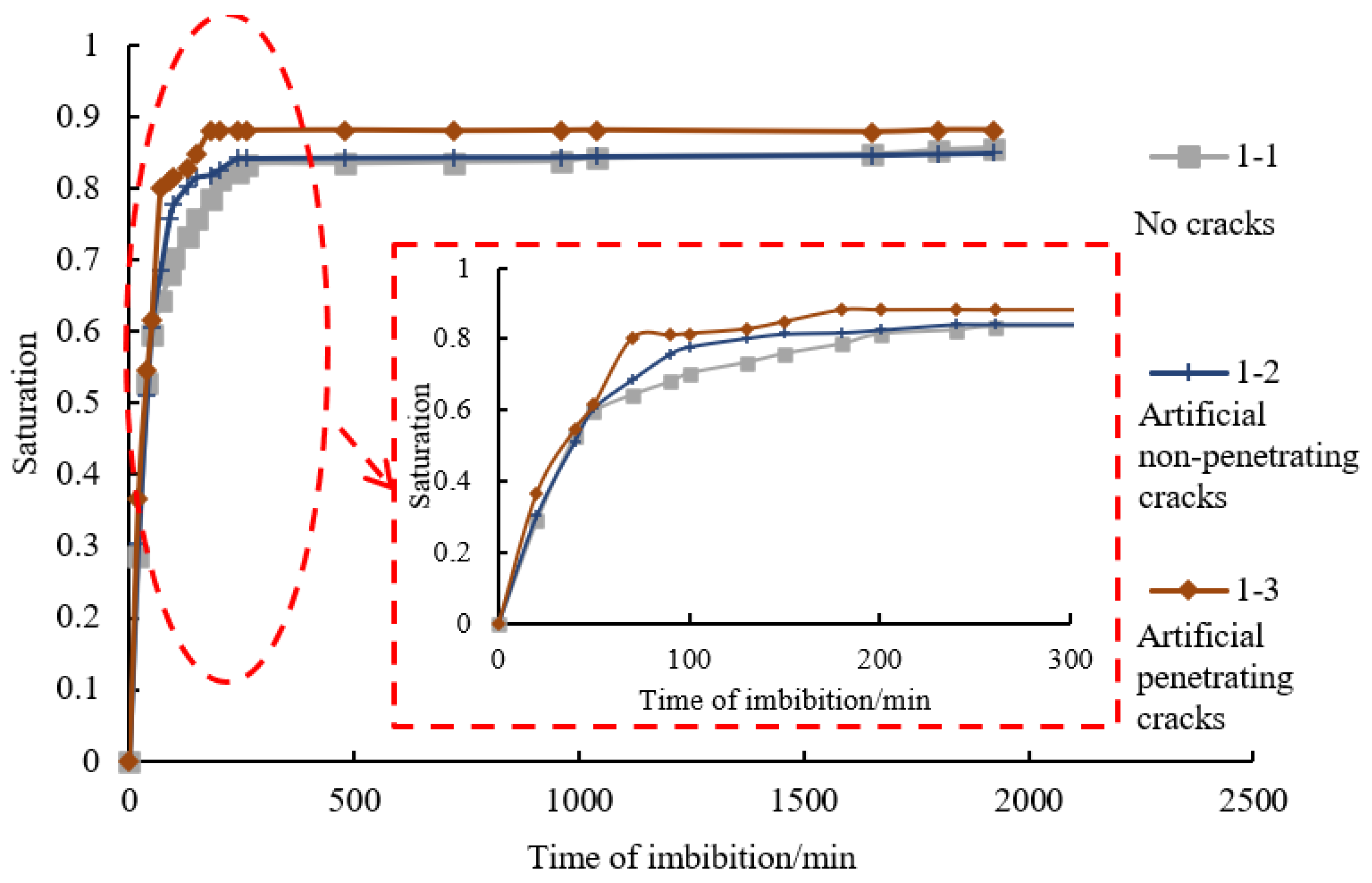



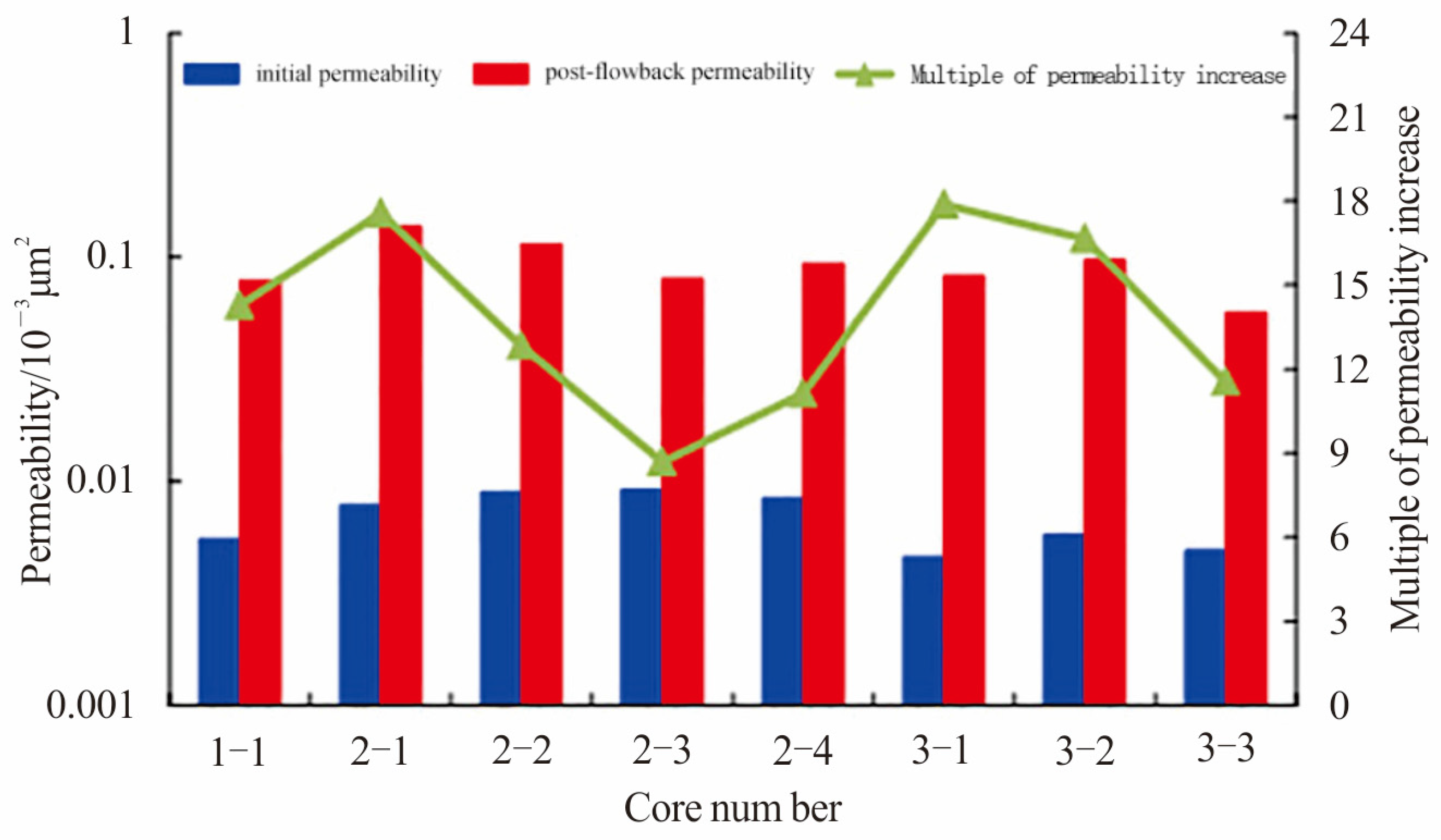
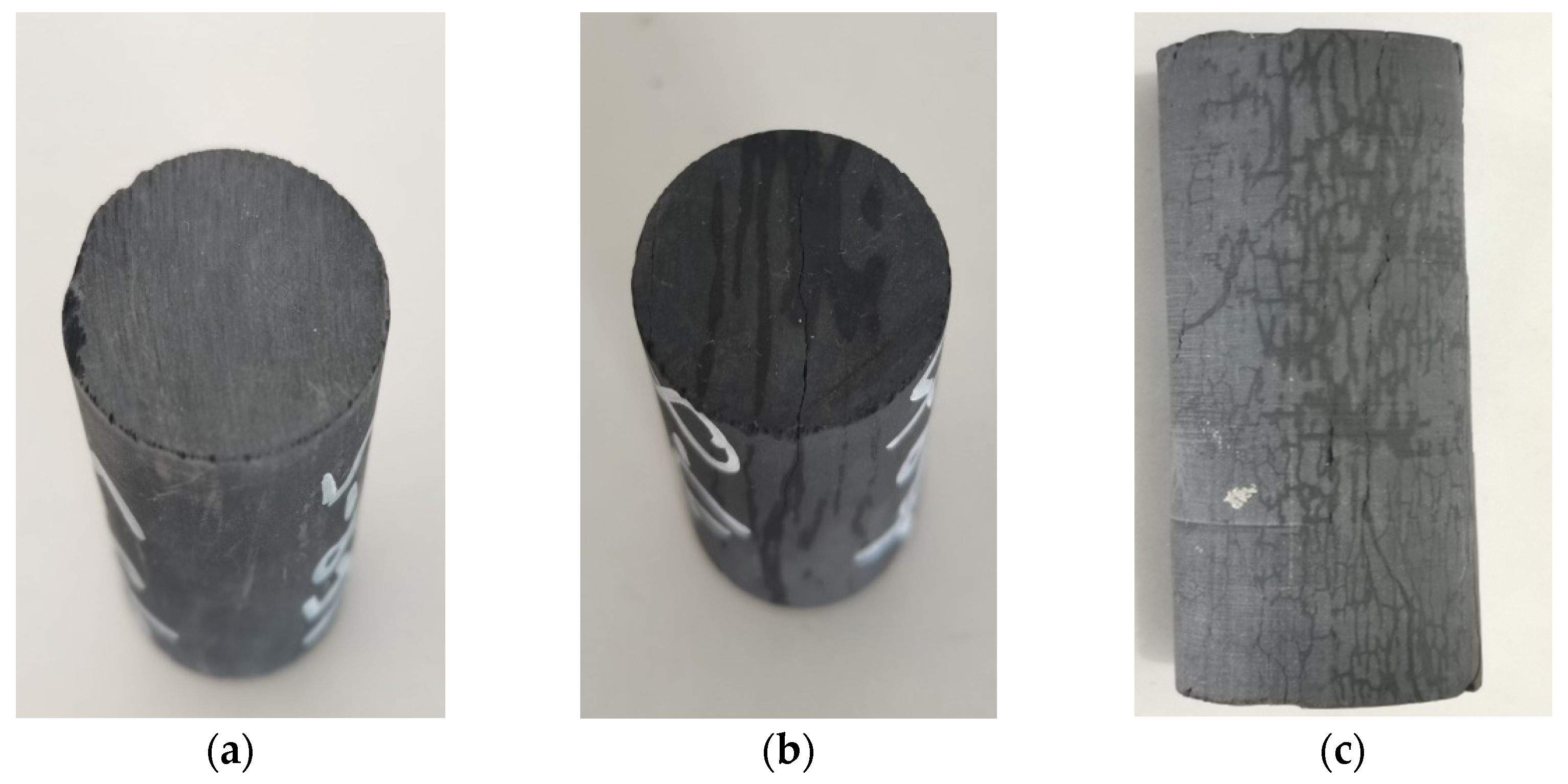
| Group | Core No. | Diameter /cm | Length /cm | Porosity /% | Permeability /10−3 μm2 | Experimental Design |
|---|---|---|---|---|---|---|
| Group 1 (for the effect of fractures) | 1-1 | 2.49 | 5.02 | 3.92 | 0.0055 | No cracks |
| 1-2 | 2.49 | 5.06 | 3.87 | 0.2320 | Artificial non-penetrating cracks | |
| 1-3 | 2.50 | 5.00 | 3.56 | 0.6284 | Artificial penetrating cracks | |
| Group 2 (for the effect of formation water salinity) | 2-1 | 2.50 | 4.98 | 3.98 | 0.0078 | Simulated formation water salinity 60,000 ppm |
| 2-2 | 2.50 | 5.08 | 4.25 | 0.0089 | water salinity 20,000 ppm | |
| 2-3 | 2.49 | 4.96 | 4.12 | 0.0092 | water salinity 6000 ppm | |
| 2-4 | 2.49 | 5.02 | 4.06 | 0.0084 | water salinity 0 ppm | |
| Group 3 (for the effect of surfactant concentration) | 3-1 | 2.50 | 5.10 | 3.56 | 0.0046 | SDBS concentration 1000 ppm |
| 3-2 | 2.50 | 5.03 | 3.74 | 0.0058 | SDBS concentration 100 ppm | |
| 3-3 | 2.49 | 5.06 | 3.78 | 0.0049 | SDBS concentration 10 ppm |
Publisher’s Note: MDPI stays neutral with regard to jurisdictional claims in published maps and institutional affiliations. |
© 2022 by the authors. Licensee MDPI, Basel, Switzerland. This article is an open access article distributed under the terms and conditions of the Creative Commons Attribution (CC BY) license (https://creativecommons.org/licenses/by/4.0/).
Share and Cite
Sun, Y.; Li, Q.; Chang, C.; Wang, X.; Yang, X. NMR-Based Shale Core Imbibition Performance Study. Energies 2022, 15, 6319. https://doi.org/10.3390/en15176319
Sun Y, Li Q, Chang C, Wang X, Yang X. NMR-Based Shale Core Imbibition Performance Study. Energies. 2022; 15(17):6319. https://doi.org/10.3390/en15176319
Chicago/Turabian StyleSun, Yuping, Qiaojing Li, Cheng Chang, Xuewu Wang, and Xuefeng Yang. 2022. "NMR-Based Shale Core Imbibition Performance Study" Energies 15, no. 17: 6319. https://doi.org/10.3390/en15176319
APA StyleSun, Y., Li, Q., Chang, C., Wang, X., & Yang, X. (2022). NMR-Based Shale Core Imbibition Performance Study. Energies, 15(17), 6319. https://doi.org/10.3390/en15176319









